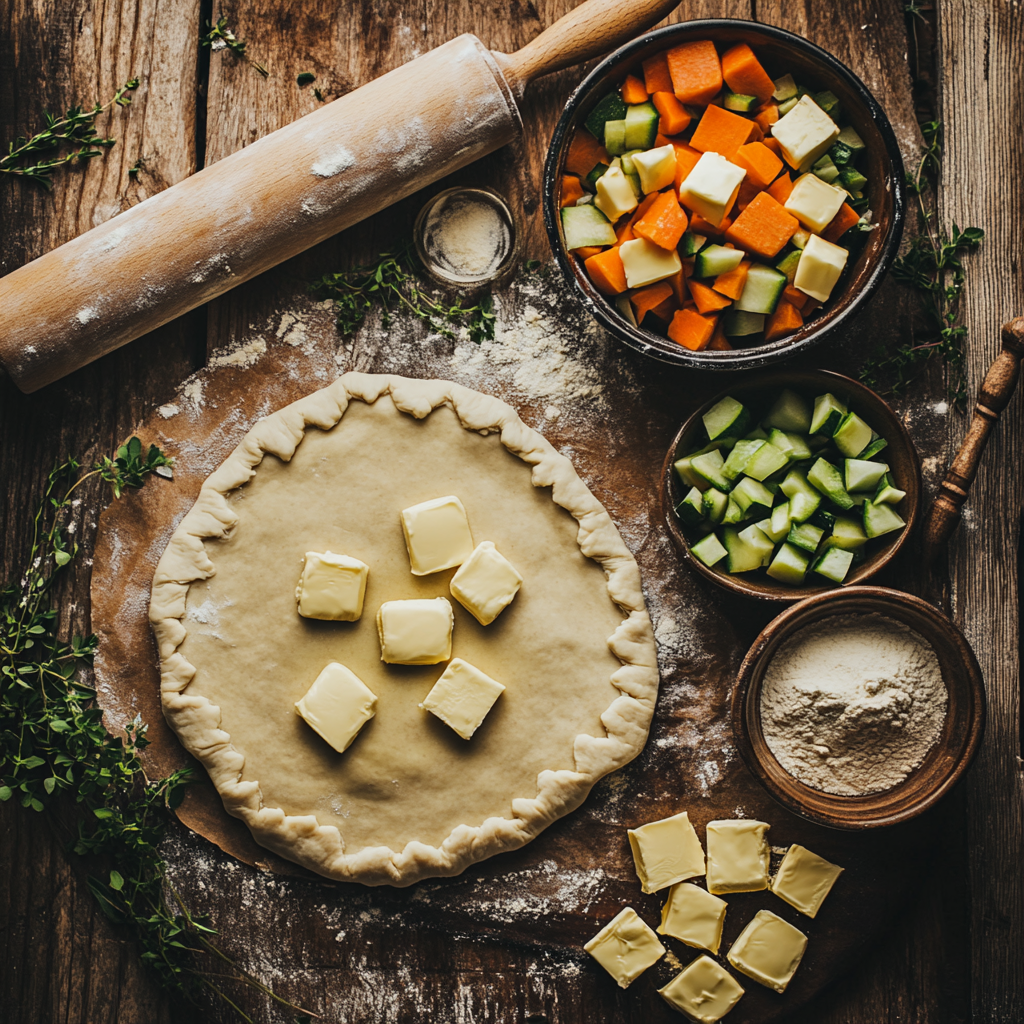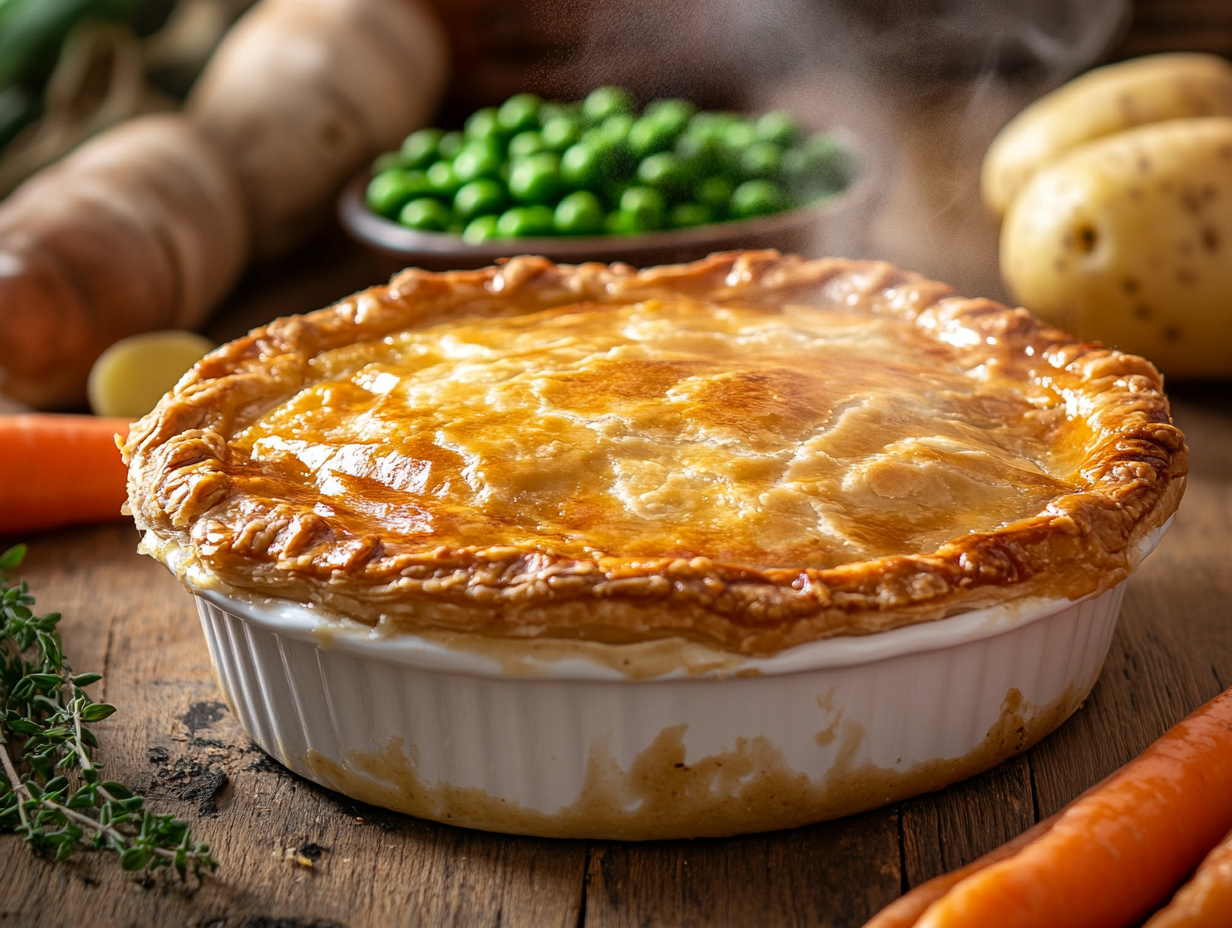Introduction
A pot pie is the epitome of comfort food—a delicious combination of flaky crust, tender vegetables, and savory meat all held together by a rich gravy. But nothing is more disappointing than a soggy crust at the bottom. If you’ve ever asked yourself, “Why is the bottom of my pot pie soggy?” you’re not alone. A soggy bottom can turn an otherwise perfect pie into a culinary letdown.
In this comprehensive guide, we’ll explore why this happens, how to avoid it, and what you can do to ensure a perfectly crisp and flaky crust every time. We’ll also reference some great recipes and tips from Keller Recipes to help you enhance your pot pie-making skills.
Whether you’re new to making pot pies or an experienced home cook looking to fine-tune your technique, this article will provide actionable insights to help you troubleshoot and perfect your pot pie recipes.
The Anatomy of a Perfect Pot Pie
Before we dive into the solutions for a soggy bottom crust, let’s first break down the components of a pot pie and how they contribute to its overall texture and flavor. A pot pie typically consists of four essential elements:
- The Crust: This is what gives the pot pie its signature flakiness and texture. The crust should be buttery, crisp, and perfectly browned, but achieving this without sogginess, especially at the bottom, can be tricky.
- The Filling: The filling usually consists of a combination of meats (like chicken or beef), vegetables (such as carrots, peas, or potatoes), and a rich gravy or sauce. This mixture must be flavorful and balanced without being overly wet.
- The Gravy: The gravy ties everything together. It’s the liquid component that provides moisture, richness, and flavor, but it can also be the culprit when it comes to a soggy bottom.
- Baking Method: How you bake your pot pie—such as the temperature, duration, and even the type of baking dish you use—can greatly affect the final product, particularly the crust.
In this guide, we’ll focus heavily on the role of the crust, baking techniques, and how to manage the filling and gravy so that you achieve a perfectly cooked pie from top to bottom.
Why Does the Bottom of My Pot Pie Get Soggy?
There are several factors that can contribute to a soggy bottom crust. Identifying the root cause of your issue is the first step toward resolving it. Below are the most common reasons why your pot pie might end up soggy:
1. Excess Moisture in the Filling

The primary reason for a soggy bottom crust is too much moisture in the filling. Pot pie fillings typically contain a mixture of cooked meats, vegetables, and gravy. If the filling has too much liquid, that moisture can seep into the bottom crust during baking, preventing it from crisping up.
How to Fix It:
- Thicken the Filling: One of the most effective ways to prevent excess moisture is to thicken the filling. You can do this by incorporating a thickening agent like flour, cornstarch, or a roux. For a perfectly thick gravy, check out What is Pot Pie Gravy Made Of? to learn the best ways to achieve the right consistency.
- Cook the Filling Before Adding It to the Pie: Pre-cooking the filling ensures that any excess moisture is evaporated before it reaches the pie crust. This method works particularly well for vegetables like mushrooms, which can release a lot of water during cooking.
2. Undercooked or Raw Crust

If you add your filling to an unbaked or undercooked crust, it might not have enough time to crisp up before the filling’s moisture begins to seep in.
Solution:
- Blind Bake the Crust: Blind baking, or pre-baking the bottom crust before adding the filling, is a great way to create a barrier against moisture. To blind bake, simply roll out your pie dough, fit it into the pie dish, and bake it for 10-15 minutes at 375°F (190°C) before adding the filling. For more tips, refer to Beef Pot Pie Recipe for an example of how blind baking is used effectively.
3. Incorrect Oven Temperature
Baking your pot pie at the wrong temperature can also cause sogginess. If the oven temperature is too low, the pie filling will cook slowly, allowing moisture to seep into the bottom crust before it has a chance to crisp up.
Solution:
- Bake at a Higher Temperature: Ideally, pot pies should be baked at a temperature of 400°F (204°C). This ensures that the crust has time to cook and crisp while the filling heats up. Lower temperatures can lead to an unevenly baked crust, with the bottom remaining soggy while the top browns too quickly.
Choosing the Right Baking Dish
The type of baking dish you use plays a crucial role in achieving a crispy bottom crust. Different materials conduct heat in different ways, which can influence how evenly your pot pie bakes.
Metal vs. Glass vs. Ceramic
- Metal Baking Pans: Metal pans, particularly aluminum or steel, conduct heat efficiently and promote even browning. They’re a great choice for achieving a crisp bottom crust.
- Glass or Ceramic Pans: These pans take longer to heat up and don’t conduct heat as effectively as metal. If using a glass or ceramic dish, you may need to extend your baking time or increase the oven temperature slightly to ensure that the bottom crust crisps up.
Advanced Tips for a Flaky, Crisp Crust
If you’re looking to take your pot pie crust to the next level, here are some additional tips to ensure flakiness and crispness:

1. Use Cold Ingredients
One of the keys to a flaky pie crust is ensuring that your ingredients—especially the butter—remain cold throughout the preparation process. Cold butter creates small pockets of steam as it melts during baking, leading to a flaky texture.
Tip:
- Chill the Dough: After preparing the dough, refrigerate it for at least 30 minutes before rolling it out. This will allow the butter to firm up and help prevent the dough from becoming too soft to work with.
2. Use a Pastry Cutter or Food Processor
When mixing your pie dough, avoid overworking it, as this can lead to a tough, dense crust. Instead, use a pastry cutter or food processor to incorporate the butter into the flour. This method ensures that the butter remains cold and is distributed evenly throughout the dough.
Technique:
- Pulse in a Food Processor: Use the pulse function on your food processor to mix the dough just until the butter is incorporated. Be careful not to overmix, as this can cause the butter to melt, resulting in a less flaky crust.
Common Ingredients That Contribute to a Soggy Crust
While excess gravy is a common culprit for soggy crusts, certain ingredients can also add too much moisture to your pie, contributing to the issue. Here are some common ingredients to watch out for:
1. Vegetables with High Water Content
Vegetables like mushrooms, zucchini, and spinach have a high water content that can be released during baking, leading to a soggy bottom crust.
Solution:
- Pre-cook Vegetables: To prevent this, sauté or roast high-moisture vegetables before adding them to your filling. This will help reduce the amount of water they release during baking.
2. Frozen Vegetables
Using frozen vegetables is convenient, but they often contain extra moisture that can be released into the pie as they thaw and cook.
Tip:
- Thaw and Drain Frozen Vegetables: Before adding frozen vegetables to your pie, thaw them completely and drain off any excess liquid. This simple step can significantly reduce the risk of a soggy crust.
The Role of Gravy in Pot Pies: Thickening and Balancing Flavors
The gravy in a pot pie serves as the glue that binds the filling together, but it can also be a source of excess moisture if not prepared correctly. A well-made gravy should be thick enough to coat the ingredients without being too runny.
How to Make the Perfect Gravy for Pot Pie:
- Start with a Roux: A roux is a mixture of flour and fat (usually butter) that is cooked together to thicken sauces. Begin by melting butter in a saucepan and stirring in an equal amount of flour. Cook the mixture for a few minutes until it turns golden brown.
- Gradually Add Liquid: Slowly whisk in your liquid—usually broth or milk—until the mixture reaches your desired consistency. Be sure to whisk constantly to avoid lumps.
- Season Well: Season your gravy with salt, pepper, and any additional spices or herbs you’d like. For more flavor ideas, check out What is Pot Pie Gravy Made Of?.
Preventing Soggy Crusts: The Importance of Oven Placement
Where you place your pot pie in the oven can make a huge difference in the outcome of the crust. If the pie is placed too high, the top crust will brown before the bottom has a chance to cook properly.
Optimal Oven Placement:
- Use the Bottom Rack: Placing the pie on the lowest rack in your oven ensures that the bottom crust is closer to the heat source, helping it to crisp up. You can also place a baking sheet on the rack below the pie to reflect heat onto the bottom of the pan.
The Impact of Steam on Pie Crust Texture
Another factor that can lead to a soggy bottom crust is trapped steam. As the pie bakes, steam is released from the filling and needs somewhere to escape. If the steam is trapped inside the pie, it can make the crust soggy.
Solution:
- Vent the Top Crust: Cutting slits or using a lattice top on your pie allows steam to escape, preventing it from building up and making the crust soggy. This technique is especially useful when working with fruit fillings, which release a lot of moisture during baking.
Enhancing the Flavor of Your Pot Pie
While preventing a soggy crust is crucial, it’s equally important to focus on the flavor of your pot pie. Here are a few tips for enhancing the taste of both the filling and the crust:
1. Add Fresh Herbs
Fresh herbs like thyme, rosemary, and parsley can add a burst of flavor to your pot pie. Sprinkle them into the filling or mix them into the pie dough for an added layer of complexity.
2. Use High-Quality Stock or Broth
The quality of your broth can make or break the flavor of your gravy. Opt for a homemade or high-quality store-bought stock to ensure that your pot pie has a rich, savory base.
3. Experiment with Different Proteins
While chicken and beef are traditional choices for pot pies, don’t be afraid to experiment with other proteins like turkey, lamb, or even seafood. Each protein brings its own unique flavor profile to the dish. For example, try the Company Shrimp Pasta Salad Recipe for seafood inspiration.
Final Thoughts on Preventing a Soggy Pot Pie Bottom
In conclusion, achieving the perfect pot pie with a crisp, golden crust is all about managing moisture and using the right techniques. By pre-cooking ingredients, blind baking the crust, adjusting your oven temperature, and venting the pie to release steam, you can avoid the dreaded soggy bottom and enjoy a deliciously flaky pot pie every time.
For even more tips and recipe ideas, explore Keller Recipes, where you’ll find everything from pot pies to creative side dishes that can elevate any meal. By mastering these techniques, you’ll never have to ask, “Why is the bottom of my pot pie soggy?” again!

